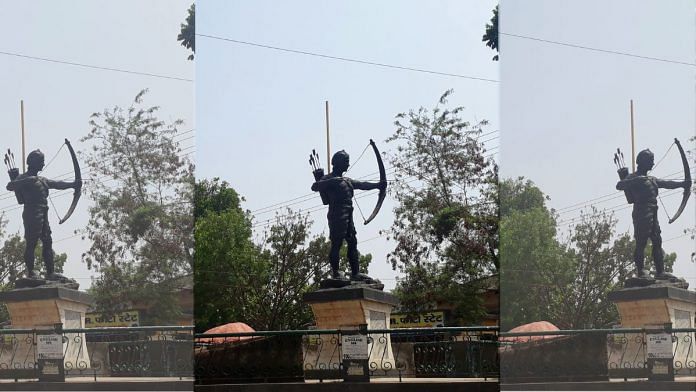
While the Company officials calculated a revised, higher tax rate, Tilka and his fellow manjhis saw their people die of hunger and sell their cattle, seeds, tools, implements and even children, to pay their taxes. Those who survived ate leaves and grass, while the government sold whatever grains were procured at high rates elsewhere. Later that year, the rains did come. But instead of providing relief, the monsoon unleashed an epidemic of smallpox. In 1771, the province was a dismal picture of barren lands and a glaring absence of people. Augustus started his career under these circumstances. His influential connections—most notably the one with Sir John Shore (later Baron John Teignmouth)—ensured that he was rapidly promoted to the assistant collectorship of Bhagalpur and Rajmahal Hills in 1776, eventually becoming the collector of the region in 1779.
Unlike Augustus, Tilka’s lineage of mystical origins was rooted in steep morals, which meant having to constantly fight for justice.
Conciliation vs guerrilla action
The lack of any initiative by the government to improve the economic condition of the people infuriated Tilka. In 1778, he issued the call to end diku raj. He acted swiftly, creating the Mukti Dal, a group of youngsters trained by Tilka that successfully drove out the Company’s army from the Ramgarh camp near Bhagalpur. Tilka led from the front, looting the government treasury and giving away the money to the needy. The masses followed suit by unleashing a host of disruptive activities like looting the dak services and residences of government officials. This event marked the onset of guerrilla warfare that would last for long.
While people focused on pushing out the Company rule, the government busied itself with the zamindars—they were encouraged to lure villagers into tilling their lands. This led to a group of Santhals migrating to the Rajmahal Hills, where the Paharias lived. The Paharias were a race of hill tribes who hunted and plundered. All attempts by the British to turn them into settled cultivators had failed, due to which the fertile lands of the hills lay barren. To the British, this amounted to the loss of revenue. The arrival of the Santhals was, thus, a boon to the government.
However, the Santhals soon discovered that through a policy of conciliation laid down by Captains Browne and Brooke between 1772 and 1779, the British had converted Rajmahal Hills into a safe haven for the Paharias called the Damin-i-Koh. As the collector, Cleveland intensified these efforts, which included providing lifelong pensions and rent-free land to the Paharia chiefs, establishing Hill Assemblies and bazaars for bartering their goods, raising a corps of hill archers and even building a school for the children. To Tilka, it seemed as if Cleveland was using a two-pronged approach of subjugation of the Santhals and conciliation towards the Paharias at the same time. He vehemently opposed this and, from 1780 onwards, he embarked on a quest to ensure that either the Santhals received the same conciliatory treatment as the Paharias or Cleveland and his system were evicted. Openly at war against the British now, Tilka and the Santhals lost no opportunity to attack Cleveland.
Also Read: ‘Gandhi did not stop here at all’—Why people in Dandi don’t say he walked that route
Death and legacy
Tilka Manjhi’s attack on Cleveland on a winter morning of 1783 left the latter bedridden for three months, after which he was advised to proceed to the Cape of Good Hope for recuperation. In early January 1784, he boarded the Atlas Indiaman in the company of Marian Hastings—the wife of Warren Hastings. However, by the time the vessel reached the mouth of the Hooghly, he had died. His body was put in a barrel of spirits and brought back to be buried in the South Park Street cemetery in Calcutta. A huge monument was erected by the Court of Directors of the East India Company in honour and recognition of his service. Given Cleveland’s proximity to the powers that were at Fort William, the attack on him was regarded as an attack on the authorities. Already harsh with their economic policies, the British authorities became even more brutal with the desire to avenge Cleveland’s death.
A massive manhunt was launched for Tilka, and he was to be brought in dead or alive. It took the Company army another year to track and nab the Santhal chief. After trying every trick in the book to isolate him in the mountainous tracks and offering a few villagers luxurious items that tempted them to give away Tilka’s whereabouts, he was finally caught on 12 January 1785.
Upon capture, the British soldiers tied Tilka to four horses and dragged him all the way to the collector’s residence at Bhagalpur. His body was soaked in blood, yet he was alive. The next day, he was publicly hanged from a banyan tree. Today, the site is the residence of the superintendent of police of Bhagalpur. On the contrary, the Tilha Kothi went on to be a temporary residence to Rabindranath Tagore, where he is believed to have written a portion of his Nobel Prize-winning work, Gitanjali. Today, it houses the Department of Ancient Indian History, Culture and Archaeology of the Tilka Manjhi Bhagalpur University
However, written records have a different story to tell. While Cleveland remained fresh in the minds of the Paharias as ‘Chilmil Saheb’ 160 years after his death, in stark contrast, as Sir John Houlton ICS found out, there were no references to Tilka Manjhi.

This excerpt from Tuhin A. Sinha and Ambalika’s ‘The Great Tribal Warriors of Bharat’ has been published with permission from Rupa Publications.

COMMENTS